Lahaina Historic District
Lahaina Historic District is a National Historic Landmark District encompassing most of the community of Lahaina, Hawaii, on the west side of the island of Maui in the US state of Hawaii. Designated in 1962, the district recognizes Lahaina for its well-preserved character as a 19th-century port, and for its social and economic importance in the 19th century as a major whaling center in the Pacific, and as one of the capital cities of the Kingdom of Hawaii.[3]
Lahaina Historic District | |
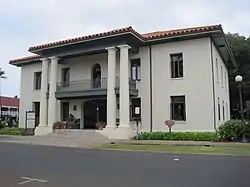 Old Lahaina Courthouse in 2010 | |
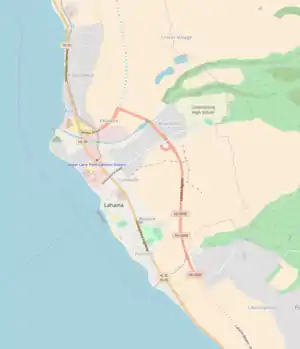 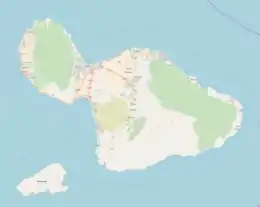  | |
| Location | W side of Maui on HI 30, Lahaina, Hawaii |
|---|---|
| Coordinates | 20°52′14″N 156°41′3″W |
| Area | 1,671 acres (676 ha) |
| NRHP reference No. | 66000302 |
| Significant dates | |
| Added to NRHP | October 15, 1966[1] |
| Designated NHLD | December 29, 1962[2] |
Donn Beach and Pete Wimberly played an important early role in establishing building ordinances to govern restoration and preservation projects in Lahaina.[4][5] It was declared a National Historic Landmark in 1962.[2][3] The district is bounded on the north by Puʻuona Point, the south by Makila Point, and the east by the ridge of hills above the town. Its western bound extends all the way out to the island of Lānaʻi, encompassing the Lahaina Roads, the roadstead which enabled the town's growth in the 19th century.[3]
Lahaina was a popular residential center for the kings of Maui prior to the arrival of European explorers in the late 18th century. Kamehameha I made his landing here when he began the conquest of Maui in 1795, and Kamehameha II established a residence here in 1819. That same year, the first whaling ships arrived, beginning the community's rise in economic importance. Lahaina eclipsed Oahu as a preferred whaling port between 1840 and 1855, because of its better deep-water anchorage. When Kamehameha III ascended to the Hawaiian throne in 1825, he made Lahaina his capital, preferring it to the busier Honolulu. The town declined in economic importance in the 1860s, as the whaling industry waned.[3]
Buildings
When the landmark district was designated in 1962, nine buildings were called out for their specific contribution to the district:[1]
| No | Name | Year | Notes | Thumbnail |
|---|---|---|---|---|
| 1 | Baldwin House | 1835 | A two-story home used by early missionaries, including Rev. Dwight Baldwin |  |
| 2 | Old Spring House | 1823 | Built by Rev. William Richards to enclose a spring and used for fresh water by the community. |  |
| 3 | Court House | 1859 | Replaced the Hale Piula, a former palace used for government offices damaged during an 1858 windstorm. Rebuilt in 1925 with significantly altered appearance. | _ELEVATION_FROM_WEST_-_Old_Maui_Courthouse%252C_Wharf_and_Canal_Streets%252C_Lahaina%252C_Maui_County%252C_HI_HABS_HI%252C5-LAHA%252C6-1.tif.jpg.webp) |
| 4 | Old Prison (Hale Paʻahao) | 1852 | Main cell block (plank structure) completed in 1852, and enclosing coral-block wall completed in 1854. Original cell block burned in 1958; reconstructed in 1959 along with the wooden gate house. | %252C_Wainee_and_Prison_Roads%252C_Lahaina%252C_Maui_County%252C_HI_HABS_HI%252C5-LAHA%252C4-3.tif.jpg.webp) |
| 5 | Waineʻe (now Waiola) Church | 1953 | Construction started in 1828 and completed in 1832. Destroyed by winds twice and again by fire in 1894. Present structure was completed in 1953, when the name was changed to Waiola. Hawaiian nobility are interred in the cemetery, which dates to 1823. | 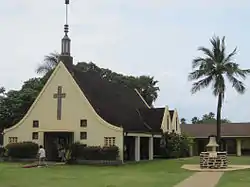 |
| 6 | Hale Aloha | 1858 | Meeting house completed in 1858, replacing an earlier stone church dating to 1823. School house and church, restored in the 1980s |  |
| 7 | United States Marine Hospital | 1842 | Herman Melville noted one of his shipmates died at this hospital in 1843. Sold in 1865 and served as a school for girls, then a vicarage for the Episcopal Church. |  |
| 8 | Maria Lanakila Catholic Church | 1858 | This church, erected in 1858, replaced an earlier church at the same site built in 1846. The present building was erected in 1928 on the same foundation, but is said to be an exact replica of the 1858 structure. | 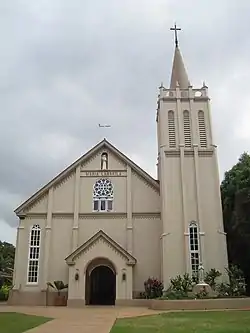 |
| 9 | Pioneer Hotel | 1901 | Lahaina's first hotel. |  |
Gallery
 Old Spring House, 1823
Old Spring House, 1823 Old Prison yard & gatehouse, 1830s
Old Prison yard & gatehouse, 1830s Old Prison outer wall, 1830s
Old Prison outer wall, 1830s Old Prison cellblock, 1830s
Old Prison cellblock, 1830s Baldwin House, 1834–1849[6]
Baldwin House, 1834–1849[6] Baldwin House with grape arbor, 1834–1849
Baldwin House with grape arbor, 1834–1849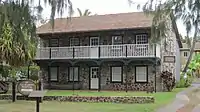 U.S. Seamen's Hospital, 1843[7]
U.S. Seamen's Hospital, 1843[7]
 Hale Aloha in 1966, before restoration
Hale Aloha in 1966, before restoration Hale Aloha with bell tower, 1858
Hale Aloha with bell tower, 1858 Hale Aloha seaward side, 1858
Hale Aloha seaward side, 1858 Old Courthouse, 1859
Old Courthouse, 1859 Pioneer Inn front desk, 1901
Pioneer Inn front desk, 1901 Pioneer Inn, 1901
Pioneer Inn, 1901 Waiola Church, renamed & rebuilt 1954[8]
Waiola Church, renamed & rebuilt 1954[8] Registered National Historic Landmark plaque, 1964
Registered National Historic Landmark plaque, 1964
References
- "National Register Information System". National Register of Historic Places. National Park Service. March 13, 2009.
- "Lahaina Historic District". National Historic Landmark summary listing. National Park Service. Archived from the original on 2011-05-11. Retrieved 2008-06-20.
- Russell A. Apple (December 21, 1973). "National Register of Historic Places/National Historic Landmark 1974 Update: Lahaina / Lahaina (historic district)" (pdf). National Park Service. Cite journal requires
|journal=(help) and Accompanying 18 photos from 1973 (32 KB) - Sinesky, Alice (September 16, 1986). "INTERVIEW WITH DONN BEACH" (PDF). The Watumull Foundation, Oral History Project.
- Bitner, Arnold (2001). Hawai'i Tropical Rum Drinks by Don the Beaschcomber. Honolulu: Mutual Publishing.
- "Lahaina Restoration Foundation: The Baldwin House". Retrieved 2010-03-27.
- "Lahaina Restoration Foundation: The Seamen's Hospital". Retrieved 2010-03-27.
- "Waiola Church: History". Archived from the original on 2016-04-22. Retrieved 2010-03-27.
External links
| Wikimedia Commons has media related to Lahaina Historic District. |
- Lahaina Restoration Foundation
- Historic American Buildings Survey (HABS) No. HI-9, "Old Maui Courthouse, Wharf & Canal Streets, Lahaina, Maui County, HI", 6 photos, 8 measured drawings, 2 data pages, 1 photo caption page